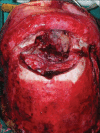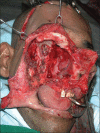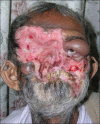Unfavourable results in skull base surgery
- PMID: 24501460
- PMCID: PMC3901905
- DOI: 10.4103/0970-0358.118599
Unfavourable results in skull base surgery
Abstract
Treatment of skull base tumors involves multiple specialities. The lesions are usually advanced and the treatment is often associated with unfavorable results, which may be functional and/or aesthetic. Here we have done an analysis for the complications and unfavorable results of 546 cases treated surgically by a single craniofacial surgeon over a period of 14 years. The major morbidity ranges from death to permanent impairment of vital organ functions (brain, eye, nose), infections, tissue losses, flap failures, treatment associated complications, psychosocial issues, and aesthesis besides others. This article is aimed at bringing forth these unfavorable results and how to avoid them.
Keywords: Skull base surgery; skull base tumours; unfavourable results.
Conflict of interest statement
Figures











References
-
- Ketcham AS, Wilkins RH, van Buren JM, Smith RR. A combined intracranial facial approach to the paranasal sinuses. Am J Surg. 1963;106:698–703. - PubMed
-
- Shah JP, Sundaresan N, Galicich J, Strong EW. Craniofacial resections for tumours involving the base of the skull. Am J Surg. 1987;154:352–8. - PubMed
-
- Shah JP. The skull base. In: Shah JP, editor. Head and neck surgery. London: Mosby-Wolfe; 1996. pp. 85–141.
-
- Ketcham AS, van Buren JM. Tumours of the paranasal sinuses: A therapeutic challenge. Am J Surg. 1985;150:406–13. - PubMed
-
- Dos Santos LR, Cernea CR, Brandao LG, Siqueira MG, Vellutini EA, Velazco OP, et al. Results and prognostic factors in skull base surgery. Am J Surg. 1994;168:481–4. - PubMed
Publication types
LinkOut - more resources
Full Text Sources
Other Literature Sources

